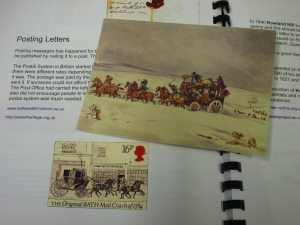It’s 175 years this year since Charles Darwin returned to Britain at the end of his five-year voyage, just as the Victorian period was beginning. He had spent his last Christmas 1835 away from home and was heading back in HMS Beagle for the final part of his epic voyage of discovery. He still had much of Australia, New Zealand, Keeling Islands, Mauritius, Cape Town in South Africa, St. Helena, Ascension Island and Brazil (again) to visit before reaching Britain. Many of these countries, especially the islands, mark the anniversary of his famous visit with postage stamps.
By October 2nd, 1836 he would be back on land in Falmouth and heading home by mail coach

Plaque marking spot of Darwin's landfall from HMS Beagle voyage, Oct 2 1836 in Falmouth and his departure home by coach.
A plaque set up by Falmouth Town Council and Falmouth Art Gallery marks the point where he made landfall in Falmouth and waited for the mail coach home. Within a year, a new Queen would be on the throne and a new era of scientific, agricultural and technological revolution begun. Lots of developments had happened in technology and society whilst he had been away, not least the beginnings of railway mania, so that the very coach he travelled on was soon to become obsolete as public transport within his lifetime.
The penny post and Penny Black stamp were only a few years aways in 1840. By the time he died in 1882, telegraph communication was widespread and telephones in their infancy. The first petrol engine vehicles were in development. Cinema experiments were beginning. Iron and steam had replaced wood and sail in modern ships. Darwin lived through an amazing century, which set the pace for the developments since.
There’s a 2009 news story and photos about the Darwin’s landfall plaque in Falmouth http://www.thisiscornwall.co.uk/news/falmouth/Plaque-marks-Darwin-landfall/article-1636415-detail/article.html
Sadly since this was put up, Brian Stewart the curator of Falmouth Art Gallery has sadly died in December 2010, much missed by the Newquay Zoo staff with whom he worked extensively on Darwin 200 activities. Many tributes can be read to his work in the Falmouth Packet newspaper. Newquay Zoo staff were already planning a follow-up to Darwin 200 based around nonsense poet and animal painter Edward Lear’s bicentenary in May 2012.
Darwin is not the only eminent Victorian to have his landing-place marked in Cornwall. We’ve included it as part of our Victorian Time Safari, looking at the legacy of Darwin’s Victorian times around us. What can you see in your village, town or city from Victorian times?
We spotted this unusual footprint when arriving by boat ferry at St. Michael’s Mount in Cornwall, that magical castle in the sea that Darwin would have passed on his route into Falmouth just up the coast.

Queen Victoria and Prince Albert 's royal visit marked by bronze plaque near her 'footstep' at St. Michaels' Mount, Cornwall (Photo: Mark Norris, Newquay Zoo)
Nearby, Truro station has all the ornate ironwork of a Victorian station still, including its VR Victorian post box. Nearby, Truro station has all the ornate ironwork of a Victorian station still, including its VR Victorian post box. On a recent Dublin trip, we saw a Victorian explorer commemorated not in stamps but in a lifesize bronze statue. What Victorain memorials or inventions can you find in your area?




